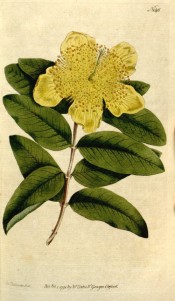Hypericum calycinum L.
Fully hardy, dwarf, evergreen or semi-evergreen shrub, spreading by runners, with oblong leaves, to 10cm long, and cymes of 2 or 3, saucer-shaped, bright yellow flowers, to 10cm across, in summer and autumn. To 60cm. [RHSE, Hortus, Hilliers’].
Horticultural & Botanical History
‘This species of St. John’s-Wort, particularly distinguished by the largeness of its flowers, has very generally been considered as the Ascyron of Linnaeus, owing to his giving to that plant the synonyms which properly belong to the present one: in his Mantissa, this species is called calycinum, which name is adopted in the 14th edition of the Systema Vegetabilium and also in the Hortus Kewensis, where the proper synonyms are applied to it, and from which we learn, that it is a native of the country near Constantinople, and was introduced into this country by Sir George Wheler, Bart. in 1676.
It is a hardy perennial, increasing much by its roots, which are of the creeping kind, and by parting of which in the autumn it is most readily propagated; like the periwinkle, it is a plant well adapted to cover a bank, or bare spots under trees, where other plants will not thrive.’ [BM t.146/1791].
Johnson’s Dictionary mistakenly describes its country of origin as Ireland, explaining the common name ‘Rose of Sharon’.
History at Camden Park
Listed only in the 1857 catalogue [T.567/1857] but certainly grown at Camden by 1853 as plants were sent to the Sydney Botanic Garden in that year. [RBGS AB].
Notes
Published Mar 18, 2009 - 04:00 PM | Last updated Mar 21, 2010 - 04:32 PM
| Family | Clusiaceae |
|---|---|
| Category | |
| Region of origin | Caucasus |
| Synonyms |
|
| Common Name | Rose of Sharon, Aaron’s beard |
| Name in the Camden Park Record | Hypericum calycinum |
| Confidence level | high |


